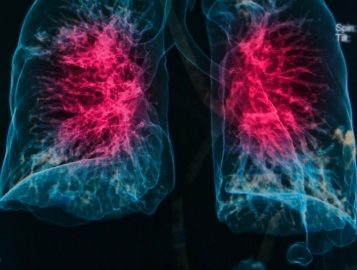Lab-Grown Lung to Aid Pulmonary Fibrosis Research

Researchers at UCLA’s Ell and Edythe Broad Center of Regenerative Medicine and Stem Cell Research have grown a three-dimensional lung in the laboratory to aid pulmonary disease research.
The scientists coated sticky hydrogel beads with stem cells derived from lung tissue. These beads grew into the shape of air sacs in real human lungs, thus creating essentially a 3-D lung model or organoid. The laboratory-grown tissue mimics a human lung and will help researchers study diseases such as idiopathic pulmonary fibrosis that are difficult to research with conventional techniques.
“While the lab-grown lung is not a fully functional one, we have duplicated the geometric placement of lung cells accurately enough to mimic a real lung,” explains Dr. Brigitte Gomperts, the lead author of the study.
As the name suggests, there is no known definitive cause for idiopathic pulmonary fibrosis. Patients with this condition have scarring in their lungs, which over time leads to progressive air hung (shortness of breath). The inability of the thick and stiff lungs to provide sufficient oxygen to the body results in damage to other vital organs. Most people do not survive more than three to five years following diagnosis of the disease. In a small number of people, the condition is inherited. Exposure to certain types of dust and cigarette smoking are known to increase the risk of developing idiopathic pulmonary fibrosis.
Traditionally, researchers rely on two-dimensional cell cultures to study lung tissue. However, when this technique is used to study the lung cells of patients with idiopathic pulmonary fibrosis, the cells do not show any abnormalities. Therefore, scientists have failed to replicate a scarred lung in a petri dish in the laboratory and have been unable to study the effects of mutations and drugs on this tissue. This inability to model a lung with idiopathic pulmonary fibrosis in the laboratory means researchers cannot study the biology of the disease or observe the effects of possible treatments.
Gompert and colleagues at UCLA took stem cells from adult lungs and used them to coat tiny beads of hydrogel. These cell-coated beads were then divided into 7 mm wells inside which lung cells then grew, forming a pattern that mimicked the three-dimensional geometry of the human lung. This model allowed researchers to perform experiments on what was essentially a lab-grown piece of real human lung. The team even succeeded in mimicking the scarring of idiopathic pulmonary fibrosis in the lab model with the introduction of some molecular factors.
The lung organoids will allow researchers to study the biology diseases such as idiopathic pulmonary fibrosis and design and test possible treatments for these conditions. The technique can be individualized in that cells from a particular patient could be used to create the model and the effects of certain drugs or treatments on that particular person’s lung tissue can be observed. The UCLA team’s success with this technique holds great promise for the future of both precision medicine and personalized treatment.
References:
- http://newsroom.ucla.edu/releases/ucla-researchers-use-stem-cells-to-grow-3-d-lung-in-a-dish


